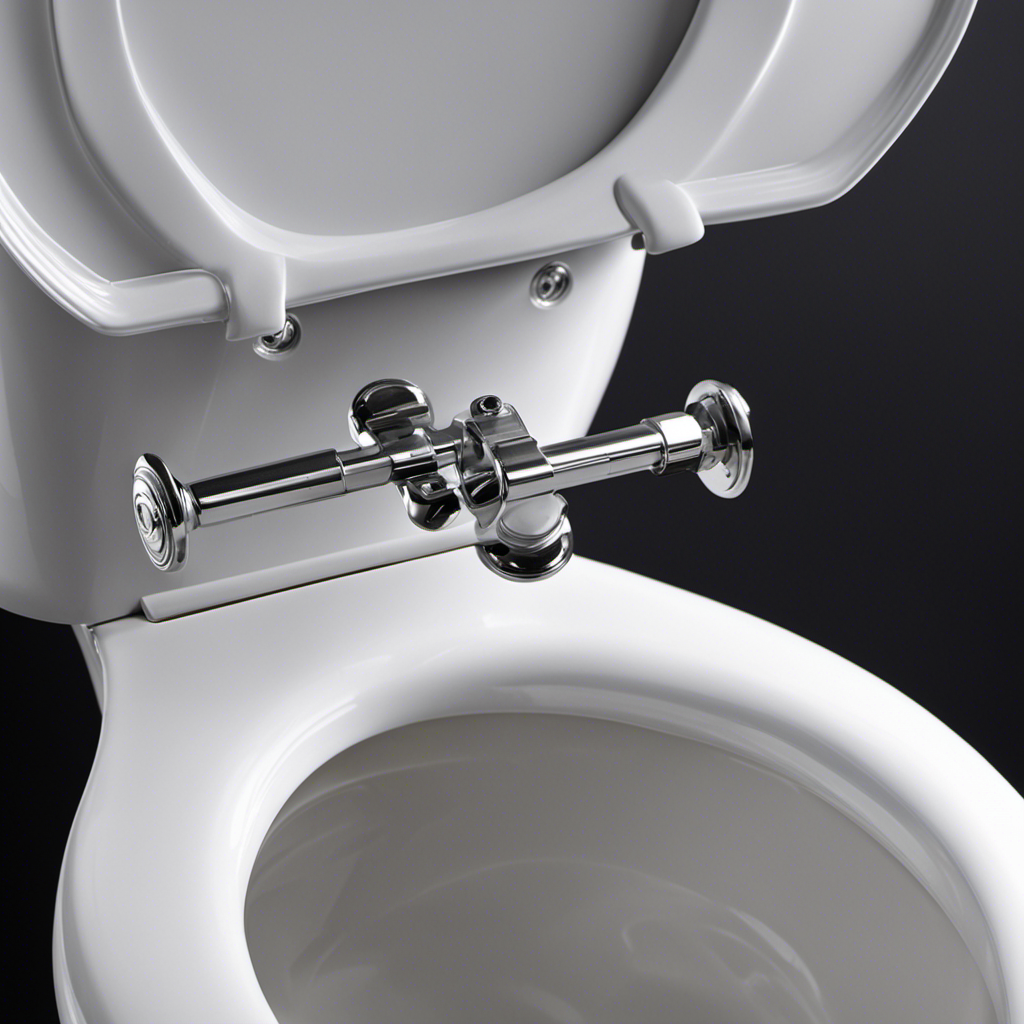Did you know that a loose or broken toilet seat hinge is a common household problem that can be easily fixed?
In this article, we will guide you through the steps to repair your toilet seat hinge, using simple tools that you probably already have at home.
By following our knowledgeable and precise instructions, you’ll be able to remove the damaged hinge, install a new one, and have your toilet seat back in perfect working order in no time.
Key Takeaways
- Loose or broken toilet seat hinge is a common household problem
- Visual inspection helps identify the issue
- Tighten loose screws with a screwdriver
- Replace broken or damaged hinges if necessary
Assessing the Problem
Now, let’s assess the problem with your toilet seat hinge and figure out what’s causing the issue.
Common toilet seat hinge issues can include loose or wobbly hinges, hinges that won’t stay up or down, or hinges that have completely broken.
Troubleshooting toilet seat hinge problems starts with a visual inspection. Check if the screws holding the hinge in place are loose or if any parts are damaged.
If the screws are loose, tighten them using a screwdriver. If the hinges are broken or damaged, you may need to replace them entirely.
In the next section, we will discuss gathering the necessary tools to fix the toilet seat hinge and walk you through the step-by-step process.
Gathering the Necessary Tools
First, you’ll need a screwdriver and pliers to gather the necessary tools for the job. Before you start replacing the hinge on your toilet seat, it’s important to troubleshoot common issues to ensure that the hinge is indeed the problem. Here is a table to guide you through this process:
| Common Issues | Possible Solutions |
|---|---|
| Loose hinge | Tighten the screws connecting the hinge to the toilet seat |
| Broken hinge | Replace the hinge with a new one |
| Misaligned hinge | Adjust the position of the hinge to align it properly |
Once you have identified that the hinge is the problem, gather your screwdriver and pliers. These tools will allow you to remove the screws and detach the old hinge. With the necessary tools in hand, you’re ready to move on to the next step in fixing your toilet seat hinge.
Removing the Damaged Hinge
With the necessary tools in hand, you’re ready to begin removing the damaged hinge.
Repairing the hinge mechanism on a toilet seat is a relatively simple task that can save you from having to replace the entire seat. If the hinge is broken or damaged, it can cause the seat to become loose or wobbly, making it uncomfortable and unsafe to use.
To remove the damaged hinge, start by locating the screws that hold it in place. Using a screwdriver, gently loosen and remove the screws. Once the screws are removed, you can easily lift the hinge out of its position.
If you’re unable to remove the hinge, there are alternative solutions available, such as using epoxy or adhesive to repair the broken parts. However, replacing the hinge entirely is often the best and most long-lasting solution.
Installing a New Hinge
To ensure a secure installation, align the new hinge with the holes on the toilet seat. Proper alignment is crucial for the hinge to function effectively and prevent any future issues. When choosing the right hinge style, consider factors such as durability, compatibility with the toilet seat, and ease of installation. There are various hinge styles available, including standard hinges, quick-release hinges, and soft-close hinges. Each style has its own advantages and features. Refer to the table below for a comparison of the different hinge styles:
| Hinge Style | Durability | Compatibility | Installation Ease |
|---|---|---|---|
| Standard Hinge | Moderate | Most toilet seats | Relatively easy |
| Quick-Release | High | Most toilet seats | Easy |
| Soft-Close | High | Most toilet seats | Moderate |
Consider your specific needs and preferences when selecting the hinge style that best suits your toilet seat.
Testing and Adjusting the Toilet Seat
Make sure you check the stability and comfort of your toilet seat by sitting on it and adjusting the position if needed. Proper maintenance for toilet seat hinges is crucial to ensure they function properly and avoid any potential issues.
Here are some troubleshooting tips to address common problems with toilet seat hinges:
-
Loose Hinges: If the hinges are loose, tighten them using a screwdriver. Make sure to not overtighten, as it can damage the seat or the bowl.
-
Hinge Cap Fell Off: If the hinge cap falls off, simply snap it back into place. If it is damaged or lost, consider replacing it to maintain the aesthetic appeal of your toilet.
-
Hinge Stuck or Difficult to Move: Apply a lubricant, such as WD-40, to the hinge mechanism to make it easier to move. Avoid using excessive force, as it can cause damage.
Conclusion
So there you have it, my friend! You’ve successfully fixed your toilet seat hinge like a true DIY pro!
Now, not only can you confidently assess the problem and gather the necessary tools, but you can also expertly remove the damaged hinge and install a shiny new one.
With your toilet seat now securely in place, you can sit back and relax, knowing that your bathroom throne is fit for a king or queen.
Bravo, my friend, bravo!










